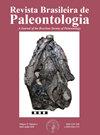巴西Bauru盆地上白垩统Adamantina组可能存在的肺鱼洞穴及其古生态古环境意义
IF 0.6
4区 地球科学
Q4 PALEONTOLOGY
引用次数: 0
摘要
脊椎动物产生了各种痕迹化石,主要是由化石和地下习性形成的足迹和通道、粪化石和洞穴。尤其是洞穴,往往代表着临时或永久的庇护所。脊椎动物洞穴在巴西中生代单元以及世界各地白垩纪岩石中的研究相对不足。本研究旨在分析上白垩纪阿达曼蒂纳组的一个古洞穴,并讨论其古生物学和古环境意义。对古洞穴形态进行了描述性研究,从方位、结构和尺寸等方面进行了研究,相关联分析为追踪者生活的古环境提供了解释。强调了古洞穴的起源,以及其可能产生者的大小,此外,还根据包含外来骨骼遗骸的埋藏学解释推断了古洞穴暴露的时间。结果表明,正如之前对备受争议的阿达曼蒂纳组所提出的那样,长期干旱的条件被洪水事件打断,如岩相分析所证明的和肺鱼洞穴所提出的。肺鱼记录的可能性也将这些动物的存在扩展到阿达曼蒂纳组,尽管需要更多的数据来了解这些组的古生态学。关键词:肺鱼,古洞穴,泛滥平原,阿达曼蒂纳组。本文章由计算机程序翻译,如有差异,请以英文原文为准。
A possible lungfish burrow in the Upper Cretaceous Adamantina Formation (Bauru Basin, Brazil) and its paleoecological and paleoenvironmental significance
Vertebrates produce a variety of trace fossils, mostly tracks and trackways, coprolites, and burrows resulting from fossorial and subterranean habits. Burrows, particularly, tend to represent temporary or permanent shelter. Vertebrate burrows are relatively understudied in the Brazilian Mesozoic units, as well as in Cretaceous rocks worldwide. This study aims to analyze a paleoburrow in the Upper Cretaceous Adamantina Formation and to discuss its paleobiological and paleoenvironmental implications. A descriptive study was carried out on the paleoburrow morphology, following aspects such as orientation, architecture, and dimensions, and facies association analysis provided the interpretation of the paleoenvironment in which the tracemaker lived. The origin of the paleoburrow was highlighted, as well as the size of its possible producer, besides inferring the exposure time of the paleoburrow from taphonomic interpretations, which contains allochthonous bone remains. The results suggest long periods of dry conditions, as previously suggested for the much-debated Adamantina Formation, interrupted by flooding events as evidenced by facies analysis and suggested by the lungfish burrow. The possibility of a lungfish record also expands the presence of these animals to Adamantina Formation, even though more data are needed to understand the paleoecology of these formations. Keywords: lungfish, paleoburrow, floodplain, Adamantina Formation.
求助全文
通过发布文献求助,成功后即可免费获取论文全文。
去求助
来源期刊

Revista Brasileira De Paleontologia
PALEONTOLOGY-
CiteScore
1.60
自引率
14.30%
发文量
25
审稿时长
>12 weeks
期刊介绍:
It publishes original contributions on all aspects of Paleontology. Papers are written in English, Spanish, or Portuguese and are reviewed by international experts.
 求助内容:
求助内容: 应助结果提醒方式:
应助结果提醒方式:


